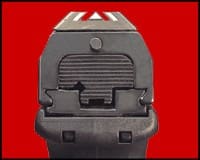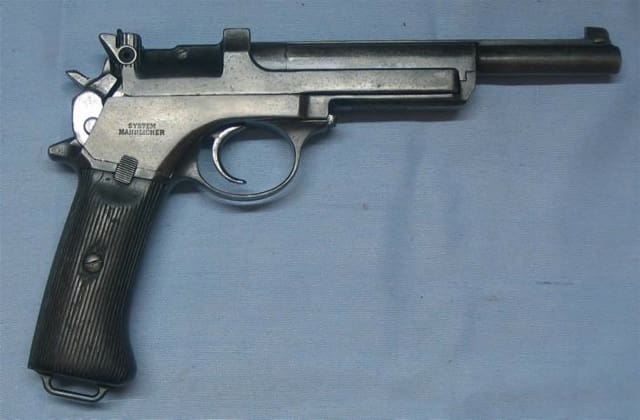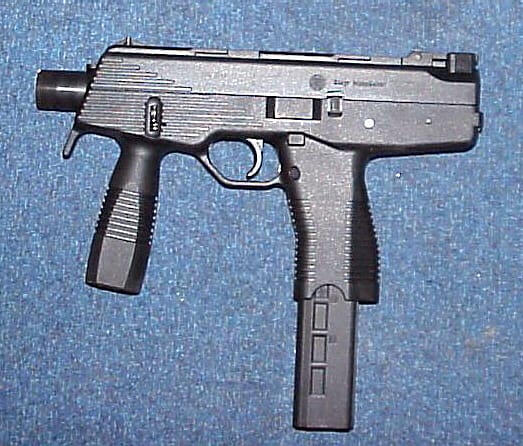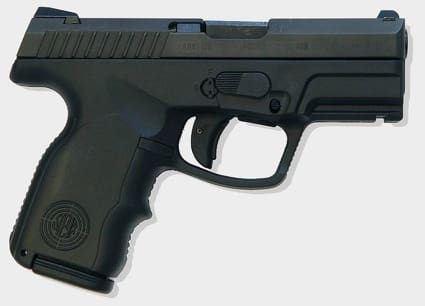When most firearms enthusiasts hear the name Steyr, they think of the AUG [above]. That’s only natural. It is Steyr’s most memorable gun. It cuts an instantly-recognizable profile. It screams “COOL” and “HIGH-TECH” at equal volume. But Steyr’s history of military and civilian gun making traces back to the late 1800s. Steyr was a serious player in the handgun game until World War 1 . . .
The late 1800s were a fertile period for gun design. The first self-loading pistols were invented, and a lot of radical concepts were explored. Steyr was part of this revolution in gun technology, and they created many interesting handguns.
Steyr made some seriously Steampunky guns, like this 1905 Steyr Mannlicher semi-auto Pistol, cal. 7.63mm Mannlicher. And they weren’t just radical in their looks.
The Steyr-Mannlicher M1894 used a unique blow-forward action. The Steyr-Mannlicher M1901/M1905 was one of the simplest blowback-operated pistols ever designed, with lockwork that closely resembles that of a single-action revolver.
Steyr wasn’t just playing around with gun design, they were looking for military business, and they found it. The Roth-Steyr M1907 was the first self-loading pistol to replace a revolver in military service, when it was adopted by the Austro-Hungarian army as a cavalry weapon.
The Steyr M1911/M1912 (also called the Steyr-Hahn) was adopted as the official Austro-Hungarian sidearm in World War 1. Neither was long in service, since they both shared an Achilles’ Heel with other European pistols of that era: they did not combine the storage of ammunition in the grip (rather than ahead of the grip like a Mauser Broomhandle) with a removable magazine to facilitate fast reloading:
Steyr also made some pocket pistols, including the post-WW2 Steyr SP (which looks very much like a Mauser HSc and Walther PPK, see above). But after WW1, Steyr was less prevalent in the handgun market. And after the SP, Steyr handguns dropped off the radar.
Steyr was not out of the game, however. Beginning in 1968 they started designing a 9mm pistol to enter into competition to become the Austrian military sidearm. This design, which would eventually become the Steyr GB, took an interesting detour in the early 1970s when an American Steyr importer obtained the blueprints and began manufacturing their own version in Illinois.
This stainless-steel pistol was called the Rogak P-18, and it was haphazardly manufactured and unreliable. Steyr took legal action to stop production of the Rogak, and in 1980 they released their own official version: the Steyr GB.
It was a pretty revolutionary design. It used a gas-delayed blowback action which made it recoil less, with few moving parts (less than 50). The frame was 2 halves that were welded together. Its 18-shot capacity (without an extended magazine) ties with the H&K VP70 as the highest available in a pistol. Does the term “wondernine” come to mind?
But disappointment was delivered to Steyr with a devastating one-two combination. In 1983 the Steyr GB lost the contract trials for the Austrian military to a then-newcomer: Glock. And in 1984 the Steyr GB was eliminated from the U.S. military trials due to reliability issues.
Steyr tried to market the GB to civilian shooters, but it was priced higher than many competing guns and the 9mm cartridge was not yet popular enough to ensure an adequate audience. Steyr stopped making the GB after 15,000 – 20,000 guns were made.
Steyr tried some other concepts as well. They designed a large select-fire pistol called the TMP (Tactical Machine Pistol) and a semi-auto version called the SPP (Special Purpose Pistol). They might look familiar to you:
Steyr did not have much success with the design, and in 2001 they sold the rights to Swiss manufacturer Brugger & Thomet, who manufacture a modified version called the MP9.
To go after the civilian & police market, Steyr created the Model M (full-size) and Model S (compact) pistols in 9mm, .40S&W and .357SiG (M only). These were polymer-framed pistols with good ergonomics and low bore axis, which debuted in 1999 and 2000:
Gun Tests magazine reviewed an M9 and an M40 and, with the exception of two light primer strikes with 1 brand of ammunition, the guns ran well. They were accurate, despite a sighting system that some users had a hard time adjusting to. Unlike the typical sighing system on a handgun (a square front post viewed through a rectangular rear notch), the Steyrs used a triangle+trapezoid sighting configuration:

The testers felt that this sighting arrangement worked OK out to 50 feet or so, but farther distances made achieving the gun’s inherent accuracy difficult with the sight picture. (The importer swapped out the Steyr sights on some guns to a more traditional post & notch arrangement).
Steyr has since updated the grip design & ergonomics and added a front rail, and the new models are the M-A1 (full-size) and S-A1 (compact).
They can be hard to find. Due to currency exchange rate fluctuations, the flow of Steyr handguns into the U.S.A. has never been steady. And with so many brands competing for space in gun store display cases, most dealers go with the more common brands like Glock, Springfield, Kahr and S&W because they have better name recognition.
But these Steyr models appear to be worthy alternatives to their most direct competitor: Glock. That isn’t a surprise, given Steyr’s long history and track record of innovation.
– – Gunnutmegger
Update: there was talk a few years back about Steyr selling sniper rifles to Iran which were then used by insurgents in Iraq/Afghanistan. There is no truth to that rumor.










How about the Steyr GB? 18+1 IIRC and debuted around the same time the Glock did.
I talked about the GB. Also provided 2 links to more info.
The Steyr GB was a rare curiosity at gun shows in the early 1990s, and is even more rare now. I was fascinated to finally see one in the flesh at a gun show, but my desire (for a shootable, practical pistol) evaporated when I held it. I remember it as an unwieldy thing, far too bulky in every dimension to justify even its then-astronomical magazine capacity.
Gunnutmegger: I’m really sorry about that. Very strange that I scrolled through the whole thing and somehow overlooked it.
Given that the G17 only gave up one round to the GB and was more robust, I think the better pistol won out (however, I am something of a Glock bigot so take it for what it’s worth.)
When it comes to self-defense arms, “rugged and simple” beats “innovative and quirky” any day of the week (see also: AK vs. M16.)
Well, Martin, in terms of reliability, that comparison is valid.
But accuracy is a strong point for the AR15 platform, as is modularity.
On balance, the real-world performance & effectiveness of both arms is well known and casts the AK in a poor light. Maybe the fact that we have a very well-trained military is the reason that we have been able to use the m16 family more effectively than our opponents have used their AKs, while minimizing its weaknesses.
Steyr M & S pistols are great weapons. I love the grip angle as well as the trapezoidial sights. Upon shooting the Steyr I found that I prefer the trap sights much more than the standard 3 dot notch & post systems that’s became the industry standard. Not only did I find them to have faster aquisition but also seemed more accurate at both long and short distances. The sight aquisition is second to none & when you pair that along with the Steyr’s low bore axis you have the recipe for extremely fast and accurate follow up shots. If you want a lightweight hi capacity semi auto look no further the steyr is the gun for you.
Comments are closed.